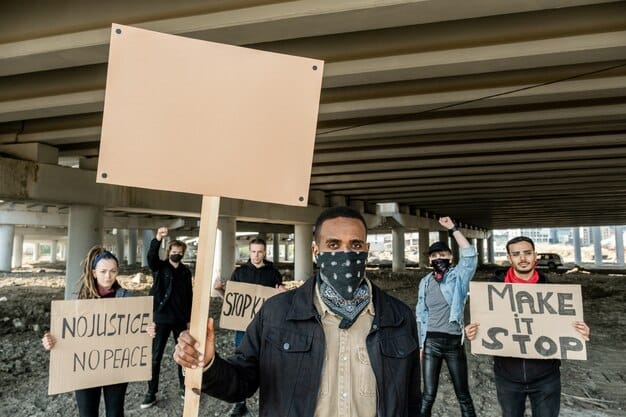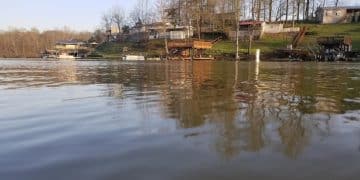How US Communities Can Fight Environmental Racism for Clean Air and Water

US communities can combat environmental racism and ensure equitable access to clean air and water through a combination of policy changes, community empowerment, investment in green infrastructure, and increased accountability for polluters, focusing on the disproportionate impact on marginalized communities.
How Can US Communities Combat Environmental Racism and Ensure Equitable Access to Clean Air and Water? This pressing question demands immediate attention as marginalized communities disproportionately bear the brunt of environmental hazards. Let’s explore actionable strategies for a more just and sustainable future.
Understanding Environmental Racism in the US
Environmental racism refers to the disproportionate impact of environmental hazards on people of color and low-income communities. These communities often face higher exposure to pollution, contamination, and the negative effects of climate change due to systemic inequities.
Root Causes of Environmental Racism
Several factors contribute to environmental racism, including discriminatory zoning laws, lack of political representation, and historical patterns of segregation.
The Impact on Communities
The consequences of environmental racism are far-reaching, affecting public health, economic opportunity, and overall quality of life. Communities exposed to environmental hazards often experience higher rates of respiratory illnesses, cancer, and other health problems.

Addressing these issues requires a multifaceted approach that acknowledges the historical and ongoing injustices faced by affected communities. It’s about not just cleaning up the environment, but also addressing the systemic inequalities that allow environmental racism to persist. This means prioritizing community involvement in decision-making processes and ensuring that resources are directed toward the areas most in need.
In recent years, there’s been a growing awareness of environmental racism, leading to increased advocacy and legal challenges. These efforts aim to hold polluters accountable and push for stronger environmental protections in vulnerable communities. Looking forward, it will be crucial to continue building alliances and advocating for policies that promote environmental justice for all.
Ultimately, combating environmental racism is about more than just environmental protection; it’s about advancing social justice and ensuring that all individuals have the opportunity to live healthy and fulfilling lives free from environmental hazards. Recognizing the problem is the first step towards creating meaningful change.
Policy Changes for Environmental Justice
One of the most effective ways to combat environmental racism is through policy changes that prioritize environmental justice. These policies should aim to prevent pollution, hold polluters accountable, and ensure that all communities have a voice in environmental decision-making.
Strengthening Environmental Regulations
Strong environmental regulations are essential for protecting public health and preventing pollution. Governments should strengthen existing regulations and develop new ones that address emerging environmental threats.
Mandating Cumulative Impact Assessments
Cumulative impact assessments consider the combined effects of multiple sources of pollution on a community. These assessments can help identify areas that are disproportionately burdened by environmental hazards and inform policy decisions.
- Prioritize community input in the assessment process.
- Ensure that assessments are conducted by independent experts.
- Use assessment results to inform zoning and permitting decisions.

Looking ahead, governments and communities must work together to implement these policy changes effectively. This includes providing resources for enforcement, monitoring, and community education. Additionally, it’s crucial to regularly evaluate the effectiveness of policies and make adjustments as needed to ensure they are achieving their intended goals.
By implementing strong environmental regulations and empowering communities, we can create a society where everyone has access to clean air and water, regardless of their race or socioeconomic status. The time for action is now, and we must all do our part to bring these policies to life.
Ultimately, addressing environmental racism requires a comprehensive approach that combines policy changes with community empowerment and investment in green infrastructure. By working together, we can create a more just and sustainable future for all.
Empowering Communities Through Education and Advocacy
Empowering communities is crucial for combating environmental racism. When residents are informed about environmental hazards and have the resources to advocate for their rights, they are better equipped to protect their health and well-being.
Community Education Programs
Education programs can help residents understand the environmental risks they face and how to protect themselves. These programs can cover topics such as air and water quality, waste management, and climate change.
Supporting Local Advocacy Groups
Local advocacy groups play a vital role in holding polluters accountable and pushing for environmental justice. Supporting these groups through funding, training, and technical assistance can amplify their impact.
Building on these strategies, it’s important to foster partnerships between communities, government agencies, and environmental organizations. These partnerships can provide additional resources and expertise to support community-led initiatives. Furthermore, encouraging youth involvement in environmental advocacy can help ensure that future generations are equipped to address environmental challenges.
In the end, empowering communities through education and advocacy is about fostering a sense of ownership and responsibility for their environment. When communities are empowered, they become active participants in shaping their own futures and creating a more just and sustainable world.
Effective community engagement requires listening to the concerns of residents, respecting their knowledge, and incorporating their input into decision-making. By prioritizing community empowerment, we can create solutions that are both effective and equitable.
Investing in Green Infrastructure and Sustainable Development
Investing in green infrastructure and sustainable development can help mitigate environmental hazards and improve the quality of life in marginalized communities. Green infrastructure includes parks, green roofs, urban forests, and other natural features that provide environmental and social benefits.
Creating Green Spaces
Creating green spaces in urban areas can help reduce air pollution, mitigate the urban heat island effect, and provide residents with access to recreation and nature.
Promoting Sustainable Development
Sustainable development practices prioritize environmental protection, social equity, and economic viability. These practices can help create healthier, more resilient communities.
- Investing in renewable energy sources, such as solar and wind power.
- Promoting energy efficiency in buildings and transportation.
- Supporting local agriculture and food systems.
Moving forward, it’s essential to integrate green infrastructure and sustainable development into broader planning efforts. This includes incorporating green infrastructure into transportation projects, housing developments, and economic development initiatives. Additionally, it’s crucial to prioritize investments in communities that have historically been excluded from these benefits.
Green infrastructure can also support local economies by creating jobs in areas such as landscaping, construction, and environmental restoration. These jobs can provide opportunities for residents to gain new skills and improve their economic well-being.
The ultimate goal is to create communities that are not only environmentally sustainable but also equitable and inclusive. This requires a long-term commitment to investing in green infrastructure and sustainable development, and prioritizing the needs of marginalized communities.
Holding Polluters Accountable
Holding polluters accountable is essential for deterring environmental violations and ensuring that communities receive compensation for environmental damage. This requires strong enforcement of environmental laws and regulations, as well as effective legal remedies for affected communities.
Increasing Penalties for Violations
Increasing penalties for environmental violations can deter companies from engaging in polluting activities. Penalties should be proportionate to the severity of the violation and should include fines, cleanup costs, and other forms of compensation.
Empowering Communities to Sue
Empowering communities to sue polluters can provide them with a powerful tool for holding companies accountable. Class-action lawsuits can be particularly effective in addressing widespread environmental damage.
Looking ahead, it’s important to ensure that communities have access to legal resources and expertise to pursue environmental claims. This includes providing funding for legal aid organizations and supporting community-based legal clinics. Additionally, efforts should be made to simplify the legal process and reduce barriers to accessing justice.
Accountability doesn’t stop with the legal process. Companies also have a responsibility to be transparent about their environmental impacts and to engage with communities in a meaningful way. This includes disclosing information about emissions, waste disposal practices, and potential environmental risks.
Ultimately, holding polluters accountable is about sending a clear message that environmental violations will not be tolerated and that communities have the right to a healthy and safe environment. By strengthening enforcement, empowering communities to sue, and promoting corporate transparency, we can create a culture of accountability that protects the environment and promotes environmental justice.
Addressing Climate Change Impacts
Climate change is exacerbating environmental injustices, as marginalized communities are disproportionately affected by extreme weather events, rising sea levels, and other climate-related impacts. Addressing climate change impacts is therefore an essential component of environmental justice.
Investing in Climate Resilience
Investing in climate resilience measures can help communities prepare for and adapt to the impacts of climate change. These measures can include building seawalls, improving drainage systems, and developing early warning systems for extreme weather events.
Transitioning to a Clean Energy Economy
Transitioning to a clean energy economy can reduce greenhouse gas emissions and create new economic opportunities in marginalized communities. This transition should prioritize investments in renewable energy, energy efficiency, and sustainable transportation.
- Supporting community-owned renewable energy projects.
- Providing job training in the clean energy sector.
- Ensuring that clean energy projects benefit local communities.
Looking to the future, it’s important to integrate climate change considerations into all aspects of planning and decision-making. This includes conducting climate vulnerability assessments, developing climate adaptation plans, and prioritizing investments in climate-resilient infrastructure.
As we transition to a clean energy economy, it’s essential to ensure that marginalized communities benefit from the new economic opportunities that are created. This includes providing job training, supporting entrepreneurship, and prioritizing investments in areas that have historically been left behind.
Addressing climate change impacts requires a global effort, but it also requires local action. By investing in climate resilience, transitioning to a clean energy economy, and prioritizing the needs of marginalized communities, we can create a more just and sustainable future for all.
| Key Point | Brief Description |
|---|---|
| 🛡️ Strengthen Regulations | Enforce stricter environmental protections. |
| 🌱 Green Investments | Fund green spaces and sustainable projects. |
| 🗣️ Community Empowerment | Educate and support local advocacy efforts. |
| ⚖️ Accountability | Hold polluters responsible for their actions. |
Frequently Asked Questions
▼
Environmental racism refers to the disproportionate impact of environmental hazards on communities of color and low-income populations due to discriminatory policies and practices.
▼
These communities often face higher pollution exposure because of discriminatory zoning laws, lack of political representation, and historical patterns of segregation that put them closer to polluting industries.
▼
Local governments can strengthen environmental regulations, mandate cumulative impact assessments, and prioritize community involvement in environmental decision-making processes to combat environmental racism.
▼
Community members can participate in education programs, support local advocacy groups, and advocate for policies that promote environmental justice to ensure their voices are heard and their concerns are addressed.
▼
Green infrastructure, such as parks and green roofs, helps mitigate hazards and improves quality of life in marginalized communities, reducing air pollution and creating spaces for recreation and community gathering.
Conclusion
Combating environmental racism requires a multifaceted approach that includes policy changes, community empowerment, investment in green infrastructure, and holding polluters accountable. By prioritizing environmental justice, we can create a more equitable and sustainable future for all communities in the US.





